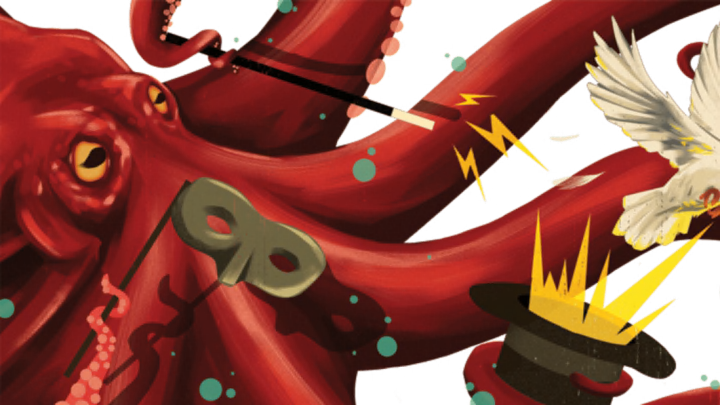1. THEY’RE THE ANIMAL KINGDOM’S BEST ESCAPE ARTISTS
Aside from its beak and braincase, an octopus is entirely squishy, meaning that a 100-pound giant Pacific octopus can squeeze through a hole about the size of a cherry tomato. They can also undo latches, untie knots, and open locks, all of which makes them extremely difficult to keep in captivity. In his 1973 book Octopus and Squid: The Soft Intelligence, Jacques Cousteau tells this charming story: “Our friend Gilpatric ... brought an octopus home and put it in an aquarium, which he then covered with a heavy lid. A short time later, the aquarium was empty, and Gilpatric found the octopus going through his library, book by book, turning the pages with its arms.”
2. THEY’RE SCARY SMART—AND KEEP THEMSELVES BUSY
Given their love of libraries, it’s no surprise that octopuses are the smartest invertebrates. They can solve puzzles, recognize human faces, navigate mazes, and even open childproof Tylenol bottles. In the 1990s, biologist Roland Anderson gave plastic pill bottles to the octopuses in his lab. Once they learned the bottles weren’t edible, all of the octopuses lost interest— except for one. A female octopus used her funnel to push the bottle to the opposite end of her tank. The water current pushed it back, and again, she pushed the bottle away. After repeating the move 18 times, Anderson had no doubt: The octopus was playing a game of bouncy ball.
3. THEY BUILD AWESOME FORTS
Since they move around to find prey, an octopus must find a new home every few days. The ideal pad is hidden, dark, and just a little larger than the octopus’s body, so octopuses will often hide in the crevice of a rock, an old seashell, the hull of a shipwreck, or a stubby brown bottle. (“If you’re determined to litter at sea but still want to keep the little octopus in mind, I suppose Red Stripe bottles might be the way to go,” writes Katherine Harmon Courage in her book, Octopus!) Once the octopus selects a house, it uses its funnel to blow debris out of the den, and then barricades the entrance with rocks to keep out unwanted visitors.
4. THEY'RE SKILLED DECORATORS
Octopuses are careful housekeepers and spend time each day cleaning the sand, gravel, and the remains of last night’s dinner from their house. Divers have learned to spot octopus dens by looking for a trash pile just outside the entrance. Female octopuses are also skilled interior decorators: They lay their eggs in long strings and attach them to the ceiling like translucent beaded curtains.
5. THEY CAN WALK ON DRY LAND
Some shallow-water species occasionally come ashore to hunt. Some have even been caught eating seagulls. But walking is just the beginning: To the chagrin of some scientists, these cephalopods can run. As a pre-veterinary student, Alexa Warburton had the tricky task of scooping octopuses out of their tanks. The stubborn animals would hide or squeeze into the tank’s cracks to avoid being removed. As a last-ditch effort, some octopuses would trampoline off the net, leap to the floor, and take off zig-zagging around the lab. It’s “like chasing a cat,” Warburton told Orion magazine.
6. THEY CAN VANISH INTO THIN WATER ...
In less than 0.3 seconds, octopuses can change their color, texture, and shape to blend in with their surroundings—transforming their skin to mimic algae-covered rocks, a sandy seabed, or fronds of kelp. (Special cells let them display different pigments, while bumps on their skin called papillae can create textures.) It’s astonishing, considering that scientists believe octopuses are colorblind. But that’s just the first act: If a predator still isn’t fooled, some species can deploy a pseudomorph—a life-size self-portrait made from a cloud of ink and mucus. The specter distracts and irritates the predator and allows the octopus to jet away.
7. ... AND THEY DO GREAT IMPRESSIONS
The mimic octopus, a smaller species that lives in the Indo-Pacific, uses its shape-shifting skills for a mind-boggling defense. Instead of convincing would-be predators that it has disappeared, T. mimicus instantly changes shape to look and act like venomous creatures, including flatfish, spiky lionfish, jellyfish, and sea snakes.
8. A SHARK IS NO MATCH FOR THEM
Concerned for the octopus’s safety, Seattle Aquarium staff were hesitant to house dogfish sharks and a giant Pacific octopus in the same tank in 2001. They did it anyway, and for a while, everything seemed calm. Then partially eaten sharks began turning up on the tank’s floor. A video camera captured the perpetrator—the octopus—following unhealthy sharks around the tank, grabbing them, and chowing down. Octopuses will also rip the stinging tentacles off a Portuguese man-o’-war and wield them like a weapon.
9. THEY’RE INNOVATIVE FOODIES
Deep inside its rubbery mantle, an octopus has a sharp beak and a toothed, tongue-like ribbon called a radula. When its super-strong arms aren’t enough to pry apart a tasty clam’s shell, the octopus uses its radula to drill a small hole in the shell, then injects a neurotoxin into the opening. The clam goes limp, the shell opens, and lunch is served.
10. THEY GET CREATIVE IN THE BEDROOM
The couch potato of the sea, octopuses will go to great lengths to avoid leaving the house. Fortunately, the male’s sex organ is at the end of one arm, so mating doesn’t have to be intimate. While some opt for the traditional mounted technique, others prefer what scientists call the “distance position.” Male and female Abdopus aculeatus adults will even find houses near one another so that the male only has to stretch his hectocotylus—or sex arm—out his front door and into the female’s house. Everybody stays safe indoors, and nobody has to buy dinner.
